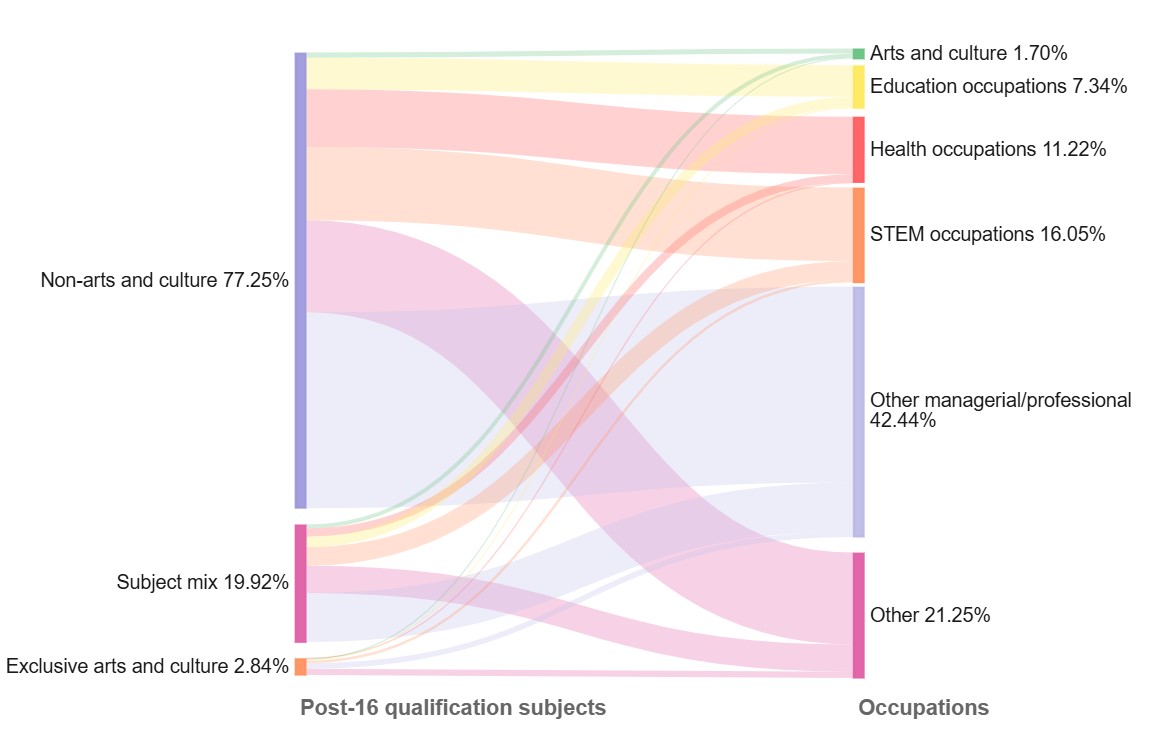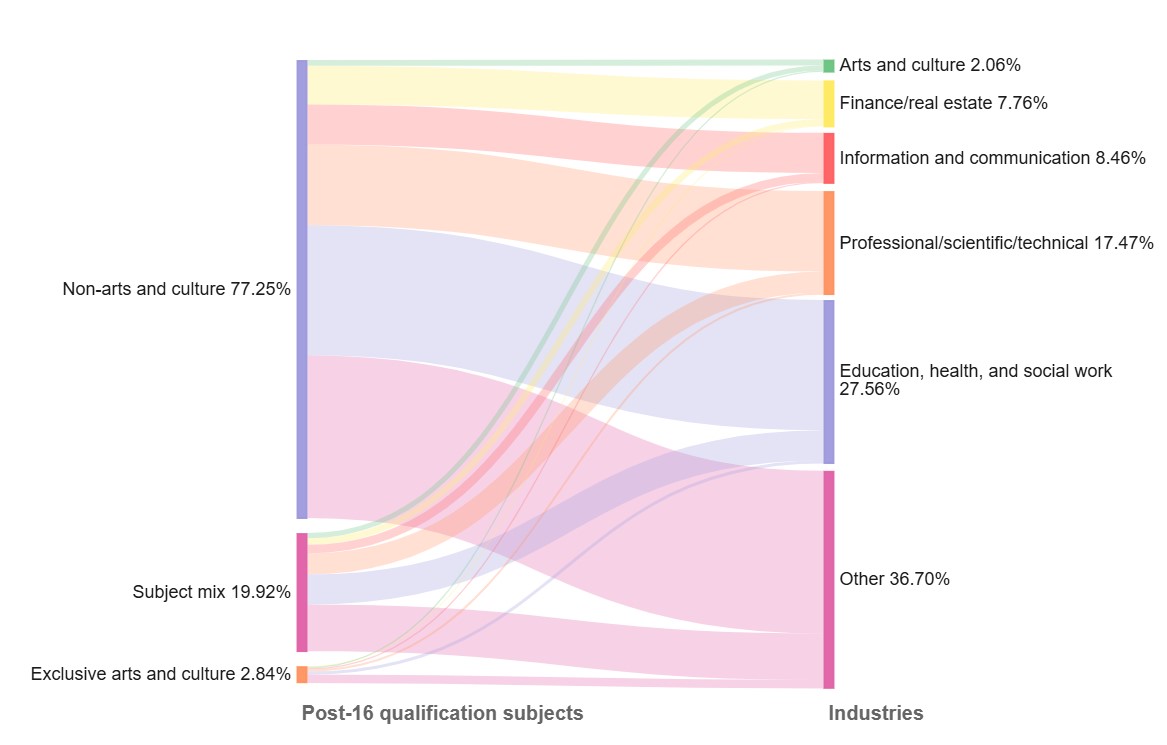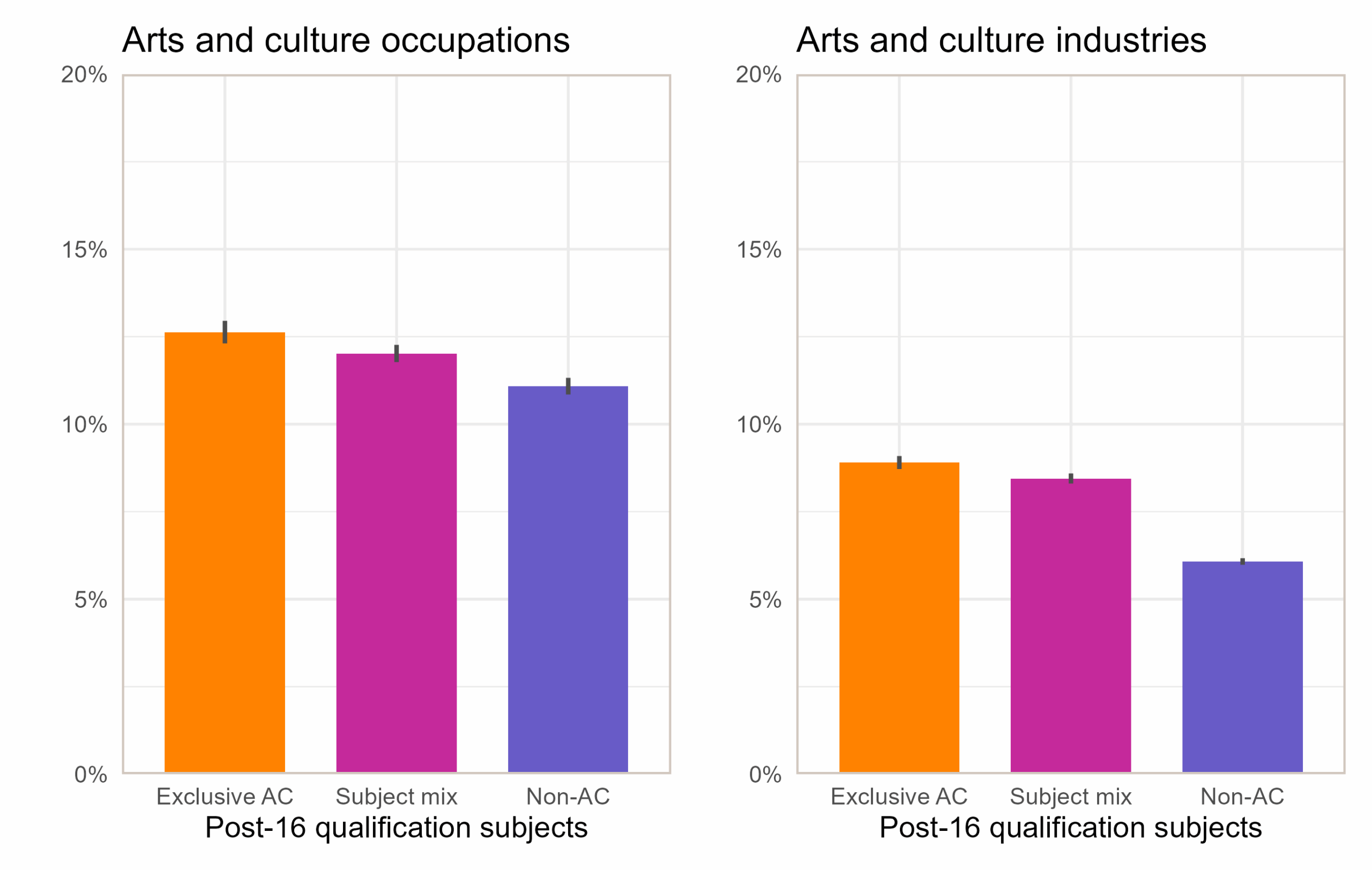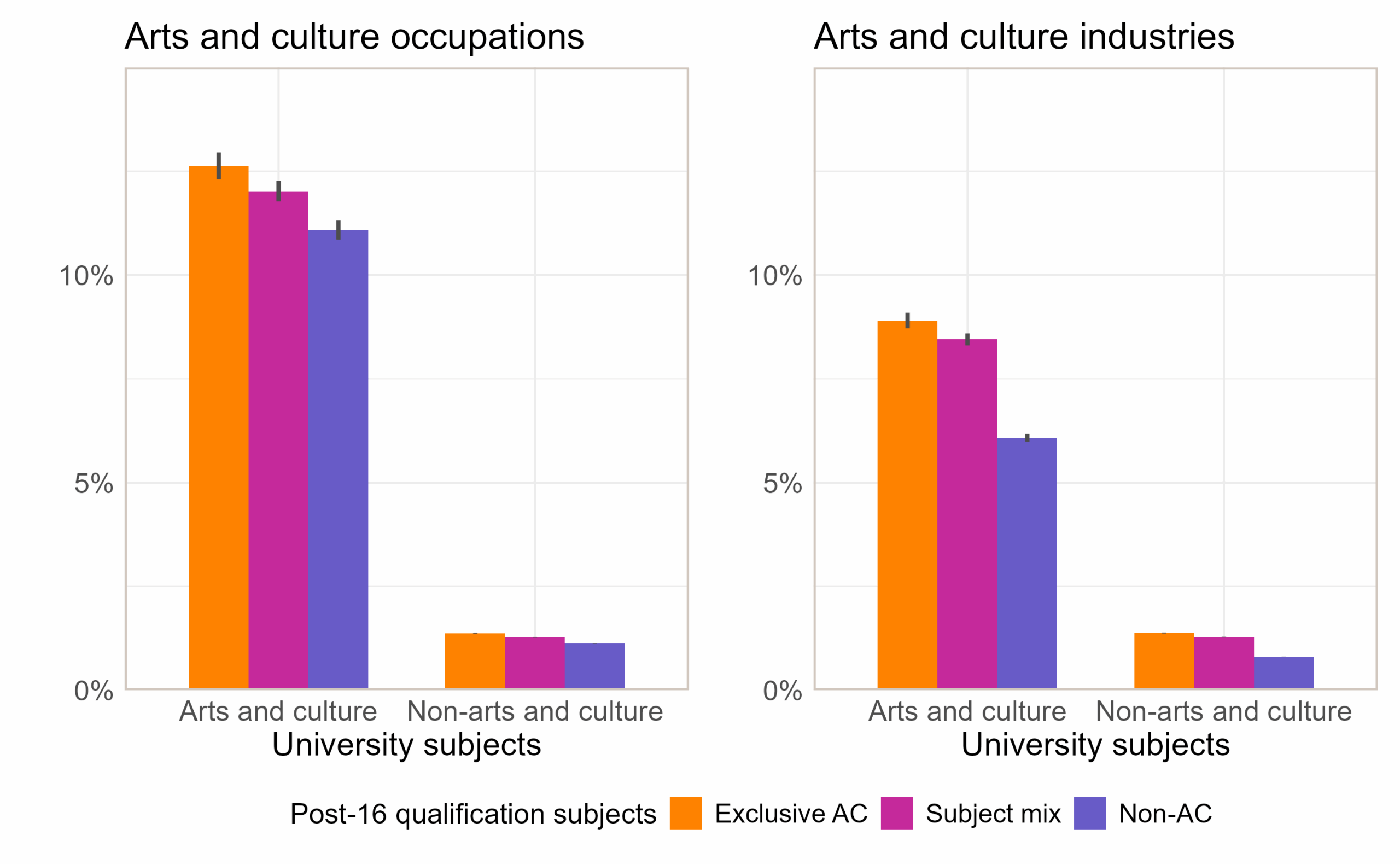Professor Dave O’Brien, Professor of Cultural and Creative Industries at University of Manchester, Dr Mark Taylor, Senior Lecturer in Quantitative Methods at University of Sheffield and Dr Ruoxi Wang, Research Associate at University of Sheffield
Studying arts and culture at university is a central route into Arts, Culture and Heritage (ACH) occupations and industries. In this blog we deep dive into some of the data in our recent State of the Nations report, Higher Education and the Arts and Culture Sectors.
The State of the Nations report presents a wealth of new analysis on Higher Education (HE), showing how arts and cultural undergraduate degree subjects have an important role in the ACH sectors. At the same time, we outline how the government and universities need to rethink how they value arts and cultural subjects in the context of low levels of graduate earnings.
There is currently significant discussion over access to arts and cultural subjects in schools and colleges. Analysis by the Campaign for the Arts suggests fewer young people are studying key arts and cultural subjects, for example entries to music A-level have almost halved since 2010. This lack of take-up of arts and cultural subjects at A-level may have implications for later ACH careers.
As in the more detailed State of the Nations report, we’ve used data from the Graduate Outcomes (GO) survey covering academic years 2017/18 to 2020/21. For the GO survey, students are surveyed 15 months after graduation. GO includes data about where graduates are living, reflections on their study, and their wages.
The ACH strand of Creative PEC’s State of the Nations series is only focused on ACH sectors, rather than the full set of creative industries. As a result, the analysis here looks at ACH occupations, such as artists, librarians and writers, and ACH industries, including photography, film, TV, and music. Occupations refer to the sorts of activities or tasks people do in their jobs. Industries refer to what organisations or businesses do, for example the goods they make or the services they provide.
Figure 1 shows the connection between post-16 qualifications (such as A-levels, Highers, and BTECs) and entry to ACH occupations, and Figure 2 shows the connection between post-16 subjects and ACH industries. We’ve clustered the post-subject qualifications into three groups of students who take only arts and culture (AC) subjects, a mix of AC and other subjects, or no AC subjects at all. AC subjects here refer to subjects associated with arts and culture occupations. These include architecture, art, creative writing, dance, design, drama, games, media production, music and music technology.
Figure 1 Transition from post-16 qualification subjects to occupations

Figure 2 Transition from post-16 qualification subjects to industries

Figures 1 and 2 show there are small proportions of students in the GO dataset who have taken exclusively AC post-16 qualifications; they also show only small proportions of any students end up in ACH occupations and industries.
In our State of the Nations report, we show how factors such as prior attainment before university and type of university attended have major impacts on access to ACH industries and occupations. We also show how demographic characteristics have important impacts too, for example gender inequalities in the labour market and in ACH industries and occupations.
- To better understand the various elements that shape the relationship between subject choice and ACH work, we’ve analysed and isolated the impacts of a range of factors.
- Graduates with either mixed or exclusive arts and culture post-16 qualifications have a significantly greater probability of working in ACH occupations and industries.
- Having university qualifications in arts and culture dramatically increases the likelihood of working in ACH occupations, such as being an artist, librarian or writer, and working in ACH industries, such as the TV or music industries.
- Graduates from Pre-92, Russell Group, and Oxbridge universities are more likely to be employed in ACH occupations compared to Post-92 graduates, whereas specialist university graduates have a higher likelihood of entering ACH industries.
We’ve presented this analysis in an appendix to this blogpost (table 1). These tables can be difficult for non-specialists to understand. An easier approach is to think about the probabilities of entering an ACH industry or occupation.
Figure 3 shows the probabilities of different sets of post-16 qualifications leading to work in ACH industries and occupations. Those most likely to make it into ACH industries and occupations are those studying exclusively arts and cultural post-16 qualifications; those with no arts and culture post-16 qualifications at all are least likely to enter ACH occupations and industries. An arts and cultural subject before university is, therefore, certainly important to accessing ACH roles.
Figure 3 Predicted probabilities of working in arts and cultural industries and occupations by post-16 qualification subjects

As we show in the State of the Nations report, the importance of university cannot be overstated. Recent work from both the Creative Diversity APPG (Comunian et al 2023) and the Sutton Trust (Brook et al 2024) has reinforced existing research demonstrating the close connection between higher education and ACH jobs. We look at this in the context of post-16 qualification choices in Figure 4.
Figure 4 Predicted probabilities of working in arts and cultural industries and occupations by post-16 qualification subjects and university subjects

Figure 4 shows the weight of impact of arts and cultural subjects at university. Irrespective of post-16 qualification subject choice, those taking arts and cultural degrees are far more likely to enter ACH occupations and industries than those in all other degree subjects.
There are several policy implications from this analysis. Two are perhaps most striking. First, is the need to ensure access to arts and cultural subjects at post-16 qualification, so students have the opportunity to add art, music, drama and similar creative post-16 qualifications to their subject mix. That subject mix of arts and culture and other subjects will help students as they try to enter ACH sectors.
Second, is the need to defend arts and cultural higher education as a route into our ACH sectors. The government has recently required that the Office for Students reduce additional funding for specific creative subjects, and the future of arts and culture provision is uncertain in the context of a forthcoming HE strategy. HE is the central point of access to these sectors, and arts and cultural degrees are key. ‘Cold spots’ of arts and cultural higher education provision, linked to the financial crisis in the sector, threaten this access.
Appendix
Table 1 Determinants of arts and culture occupations and jobs
| CCI SOC | CCI SIC | |
| (1) | (2) | |
| Post-16 qualification subjects (Ref: Non-arts and culture) | ||
| Subject mix | 0.048** | 0.173*** |
| (0.020) | (0.016) | |
| Exclusive arts and culture | 0.078** | 0.202*** |
| (0.032) | (0.028) | |
| University subjects (Ref: Non-arts and culture) | ||
| Arts and culture | 1.060*** | 0.857*** |
| (0.022) | (0.018) | |
| Total tariff points | 0.006 | -0.024 |
| (0.015) | (0.015) | |
| Gender (Ref: Female) | ||
| Male | -0.017 | -0.005 |
| (0.012) | (0.011) | |
| Ethnicity (Ref: White) | ||
| Asian | -0.327*** | -0.247*** |
| (0.026) | (0.022) | |
| Black | -0.186*** | -0.065** |
| (0.034) | (0.027) | |
| Mixed | -0.010 | 0.051** |
| (0.029) | (0.026) | |
| Other | -0.208*** | -0.122** |
| (0.070) | (0.058) | |
| School (Ref: State-funded) | ||
| Private school | -0.013 | -0.042** |
| (0.020) | (0.019) | |
| POLAR quintile (Ref: Q1) | ||
| Q2 | -0.021 | 0.026 |
| (0.026) | (0.025) | |
| Q3 | 0.018 | 0.055** |
| (0.025) | (0.024) | |
| Q4 | 0.019 | 0.039* |
| (0.024) | (0.023) | |
| Q5 | -0.002 | 0.070*** |
| (0.024) | (0.023) | |
| NS-SEC origin (Ref: NS-SEC I) | ||
| NS-SEC II | 0.035** | 0.046*** |
| (0.016) | (0.015) | |
| NS-SEC III-V | -0.022 | -0.002 |
| (0.018) | (0.016) | |
| NS-SEC VI-VIII | -0.056*** | -0.077*** |
| (0.022) | (0.020) | |
| Other | -0.001 | -0.038* |
| (0.021) | (0.020) | |
| Disability (Ref: No known disability) | ||
| Known disability | 0.027* | 0.043*** |
| (0.016) | (0.015) | |
| Skills | 0.192*** | 0.041*** |
| (0.015) | (0.013) | |
| Qualification | 0.122*** | -0.146*** |
| (0.020) | (0.016) | |
| University type (Ref: Post-92) | ||
| Specialist | 0.015 | 0.159*** |
| (0.033) | (0.029) | |
| Pre-92 | 0.064*** | 0.046*** |
| (0.017) | (0.016) | |
| Russell Group | 0.166*** | 0.052*** |
| (0.016) | (0.016) | |
| Oxbridge | 0.393*** | 0.029 |
| (0.040) | (0.046) | |
| Location | Yes | Yes |
| Yes | Yes | |
| Acyear | Yes | Yes |
| Yes | Yes | |
| Observations | 344,158 | 344,158 |
| Log Likelihood | -16,158.520 | -19,224.600 |
Note: Robust standard errors in parentheses. *** p<0.01, ** p<0.05, * p<0.1.
Photo by Desola Lanre-Ologun on Unsplash
